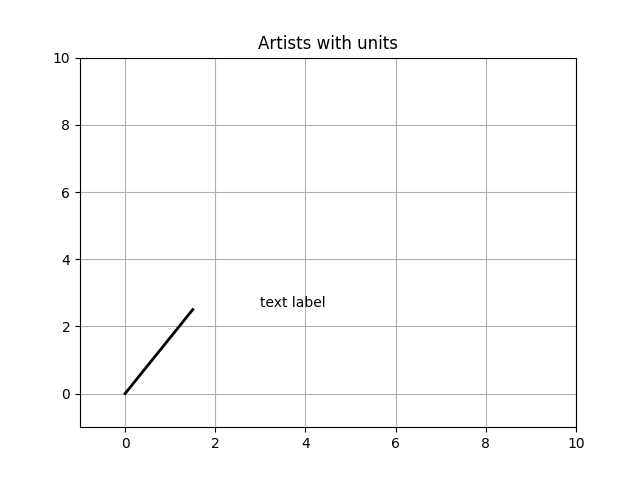Notiz
Klicken Sie hier , um den vollständigen Beispielcode herunterzuladen
Künstlertests #
Testeinheitsunterstützung mit jedem der primitiven Matplotlib-Künstlertypen.
Die Achse verarbeitet Einheitenkonvertierungen und die Künstler behalten einen Zeiger auf ihre übergeordnete Achse. Sie müssen die Künstler mit der Achseninstanz initialisieren, wenn Sie sie mit Einheitendaten verwenden möchten, sonst wissen sie nicht, wie sie die Einheiten in Skalare konvertieren.
Dieses Beispiel erfordertbasic_units.py

import random
import matplotlib.lines as lines
import matplotlib.patches as patches
import matplotlib.text as text
import matplotlib.collections as collections
from basic_units import cm, inch
import numpy as np
import matplotlib.pyplot as plt
fig, ax = plt.subplots()
ax.xaxis.set_units(cm)
ax.yaxis.set_units(cm)
# Fixing random state for reproducibility
np.random.seed(19680801)
if 0:
# test a line collection
# Not supported at present.
verts = []
for i in range(10):
# a random line segment in inches
verts.append(zip(*inch*10*np.random.rand(2, random.randint(2, 15))))
lc = collections.LineCollection(verts, axes=ax)
ax.add_collection(lc)
# test a plain-ol-line
line = lines.Line2D([0*cm, 1.5*cm], [0*cm, 2.5*cm],
lw=2, color='black', axes=ax)
ax.add_line(line)
if 0:
# test a patch
# Not supported at present.
rect = patches.Rectangle((1*cm, 1*cm), width=5*cm, height=2*cm,
alpha=0.2, axes=ax)
ax.add_patch(rect)
t = text.Text(3*cm, 2.5*cm, 'text label', ha='left', va='bottom', axes=ax)
ax.add_artist(t)
ax.set_xlim(-1*cm, 10*cm)
ax.set_ylim(-1*cm, 10*cm)
# ax.xaxis.set_units(inch)
ax.grid(True)
ax.set_title("Artists with units")
plt.show()